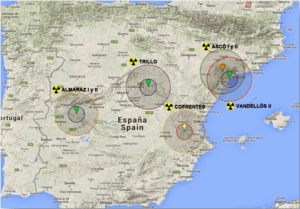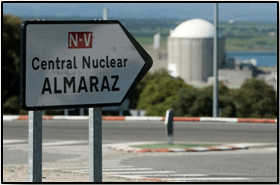A Central Nuclear de Almaraz dista da capital, Madrid, cerca de 200 quilómetros. Do território português pouco mais que 100 Km. Situa-se em Cáceres, província da Estremadura Espanhola. Almaraz torna-se, assim um problema português, especialmente agora que o governo espanhol pretende prolongar a vida da central
A autorização do projeto data de 29 de outubro de 1971. A sua construção concretiza-se a 2 de julho de 1973, por sinal, no mesmo ano em que se iniciou a empreitada de construção do complexo. Colocar em funcionamento, em 1981, esta central nuclear foi um processo. Foi a quarta central espanhola a abrir portas e a primeira da segunda geração. Quanto aos incidentes, os problemas técnicos surgiram quase que de imediato, erros e paragens não programados, algo que afetou alguns elementos essenciais quanto à sua segurança. A juntar a tudo isto, refere o Movimento Ibérico Antinuclear, mais de 4.000 modificações de desenho realizadas durante a sua vida útil, incluindo a mudança dos geradores de vapor.
Apesar da central nuclear se encontrar em território espanhol, este é mesmo um problema português. E porquê? São as águas do rio Tejo que fazem a refrigeração deste complexo radioativo. Daí este intrincado esquema internacional. Afinal, a água transmite radiação e todos sabemos por onde passa o Tejo e, em última análise, onde desagua. Multiplicaram-se os incidentes, com menos ou mais gravidade até ao ano passado. 11 de janeiro de 2016 é a data onde se detecta uma falha numa das bombas de refrigeração do circuito terciário de Almaraz, conhecido como serviço de águas essenciais.
Com tamanho histórico de uma central cujo tempo de vida útil terminou há 5 anos a situação é de meter medo, a espanhóis e portugueses. É que todo o complexo nuclear funciona com margens de segurança consideradas insuficientes, pois é possível trabalhar com bombas afetadas por um problema de desenho que pode causar falhas no circuito terciário, o que pode causar a deficiente extração do calor ao circuito secundário, o que por sua vez, coloca em causa o circuito primário. Enfim, uma sucessão de problemas em cadeia que podem resultar numa tragédia a curto, médio e longo prazo.
Assim, e perante as evidências e exemplos dos efeitos das deficiências e riscos na exploração da energia nuclear, lembro Chernobyl, na então URSS , ou Fukushima, no Japão. Há quem clame pelo encerramento da Central Nuclear de Almaraz. O argumento mais forte prende-se com o prazo em que termina oficialmente o seu funcionamento, ou seja, junho de 2020.
É certo que faltam alguns anos, e agora o governo está a tentar ar ranjar motivos para prolongar a vida útil da central: construir um edifício de armazenagem de resíduos radioativos… Não fora, mas dentro do perímetro de Almaraz. Se conseguirá ou não é uma incógnita. A decisão do governo espanhol está tomada e coube ao governo português apresentar queixa à comissão europeia que é quem vai decidir o tal sim ou não sobre a construção da dita obra. Uma coisa parece certa, se a autorização for dada vamos ter um perigo a porta por mais anos, talvez muitos anos. O dito armazém será a chave ou a estratégia para a continuação da laboração da Central Nuclear. O perigo radioativo não respeita fronteiras. O ar é de todos… e mais, o Tejo está aqui tão perto.
ranjar motivos para prolongar a vida útil da central: construir um edifício de armazenagem de resíduos radioativos… Não fora, mas dentro do perímetro de Almaraz. Se conseguirá ou não é uma incógnita. A decisão do governo espanhol está tomada e coube ao governo português apresentar queixa à comissão europeia que é quem vai decidir o tal sim ou não sobre a construção da dita obra. Uma coisa parece certa, se a autorização for dada vamos ter um perigo a porta por mais anos, talvez muitos anos. O dito armazém será a chave ou a estratégia para a continuação da laboração da Central Nuclear. O perigo radioativo não respeita fronteiras. O ar é de todos… e mais, o Tejo está aqui tão perto.
_________________
A Portuguese environmental problem called ALMARAZ …
The Almaraz Nuclear Power Plant is located in Cáceres, province of Spanish Extremadura – about 200 kilometers from the capital, Madrid. Of the Portuguese territory is about 100 Kilometers far. Almaraz thus becomes a Portuguese problem, specially now that the Spanish government is trying to find reasons to extend the life of the plant.
The authorization of the project dates from October 29, 1971. Its construction took place on July 2, 1973, by the way, in the same year in which the construction of the complex began. Putting into operation this nuclear power station was a process, from the beginning full of incidents, from 1981. It was the fourth Spanish central to open doors and the first of the second generation. As for the incidents, the technical problems arose almost immediately, errors and unscheduled stops, which affected some essential elements regarding their safety. In addition to all this, refers to the Iberian Antinuclear Movement, More than 4,000 design modifications made during its life, including the change of steam generators.
Although the nuclear power station is in Spanish territory, this is a Portuguese problem. It’s because? It is the waters of the Tejo River that make the cooling of this radioactive complex, hence this intricate international scheme. After all, water transmits the radiation and we all know where the Tagus passes and, ultimately, where it drains. For this reason, the aforementioned Antinuclear Movement of Incidents points to the year 1983 as the beginning of the danger, the contamination of the secondary circuit of Unit One. The incidents were multiplied, with less or more seriousness until last year. January 11, 2016 is the date where a fault is detected in one of the Almaraz tertiary circuit cooling pumps, known as the essential water service.
With historical size of a central whose useful life ended 5 years ago the situation is to put fear, the Spaniards and Portuguese. It is that the whole nuclear complex works with safety margins, considered insufficient since it can allow it to work with bombs affected by a design problem that can cause failures in the tertiary circuit, which can cause the poor extraction of the heat to the secondary circuit, which in turn, jeopardizes the primary circuit. A succession of chain problems that can result in short-, medium- and long-term tragedy.
So, given the evidence and examples of the effects of deficiencies and risks in the exploration of nuclear energy, I recall Chernobyl, in the then USSR, or Fukushima, in Japan, there are those who call for the closure of the Almaraz Nuclear Power Plant. The strongest argument relates to the period in which it officially ends, June 2020.
It is certain that it is a few years away, and now the government is trying to find reasons to extend the life of the plant: building a building for the storage of radioactive waste … not outside but within the perimeter of Almaraz. Whether it will or will not be unknown. The decision of the Spanish government is taken and it was up to the Portuguese government to present a complaint to the European commission that is going to decide whether or not to do so. One thing seems certain, if the authorization is given we will have a danger to the door for more years, maybe many years. The said warehouse will be the key or the strategy for the continuation of the work of the Nuclear Power Plant. The radioactive danger does not respect borders. The air is of all … and more, the Tagus here so close.




You must be logged in to post a comment.